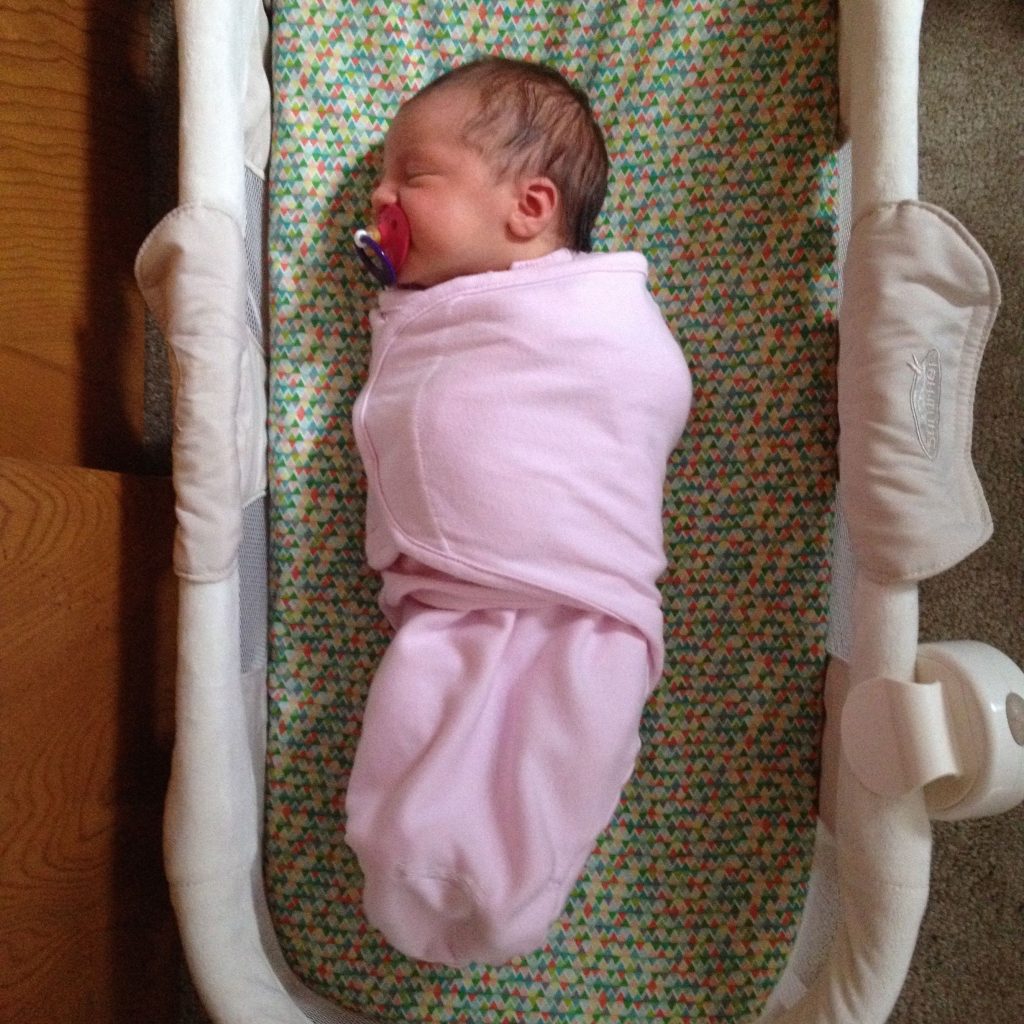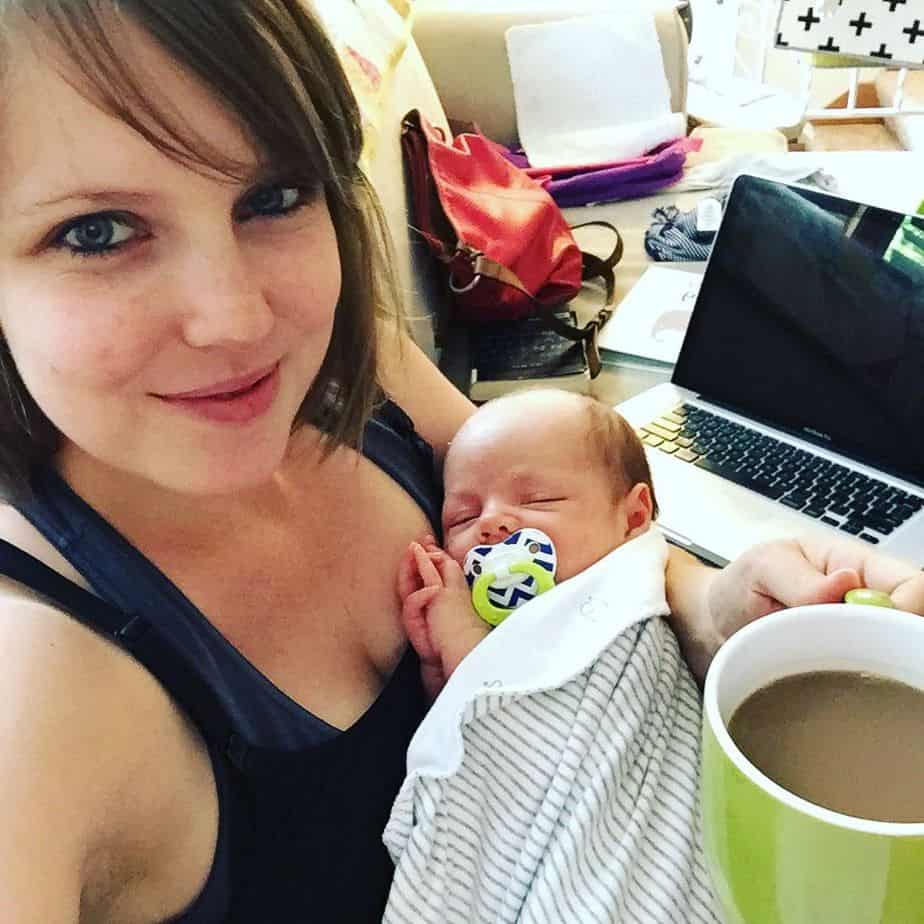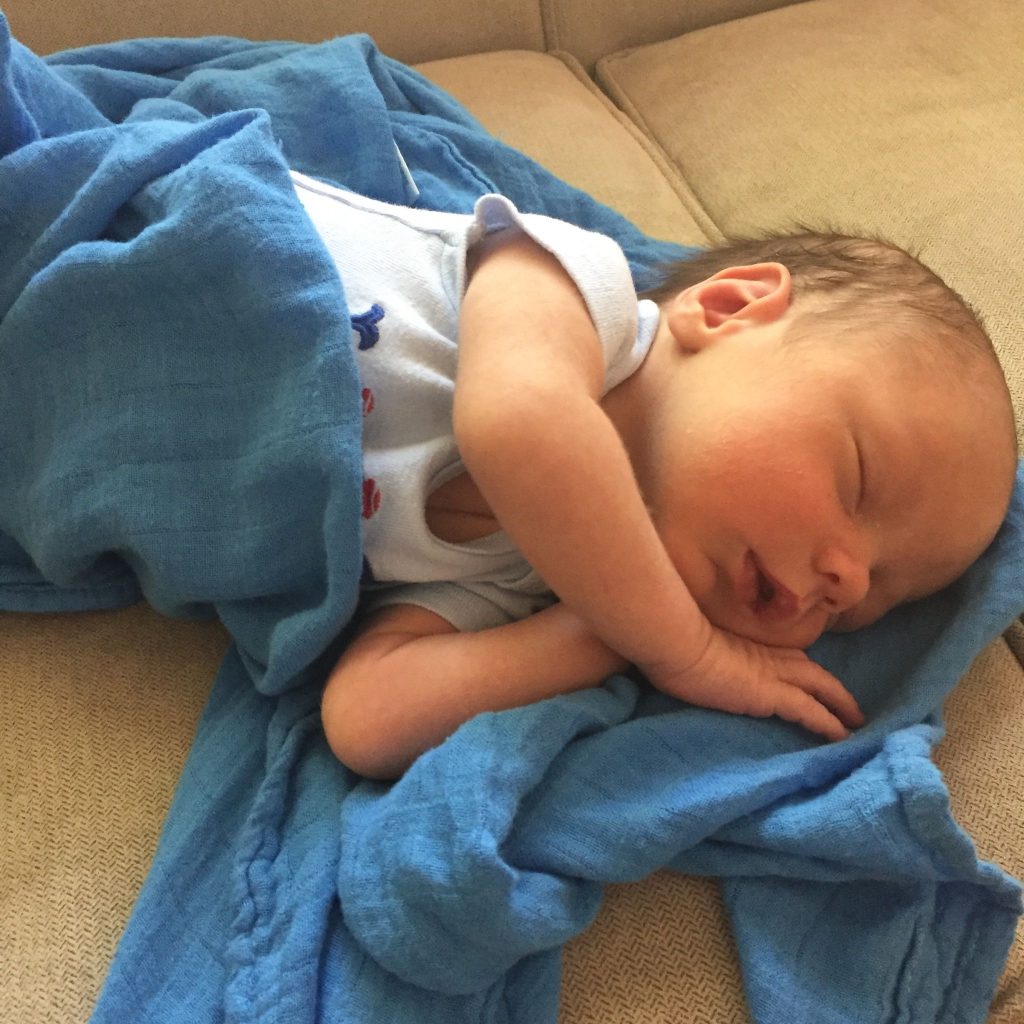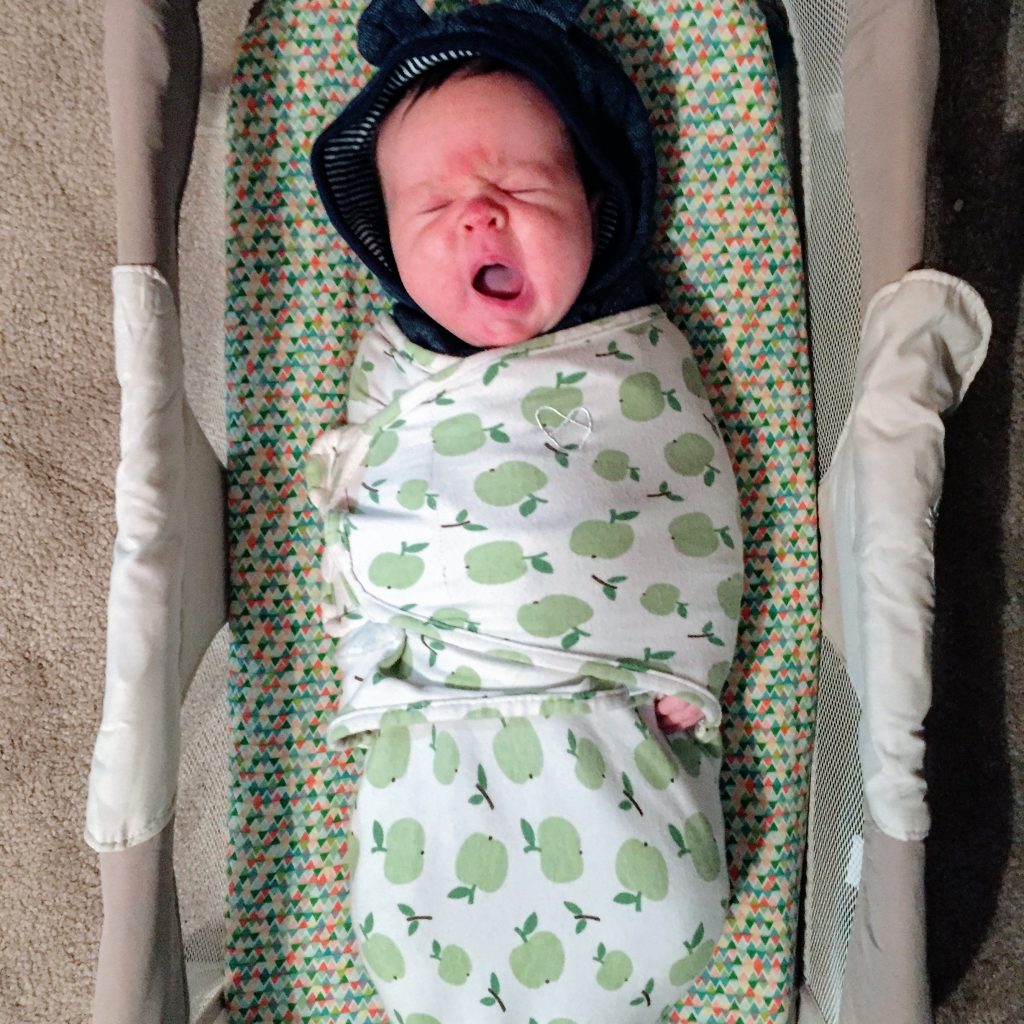Some of the links on this page are affiliate links. When you make a purchase through an affiliate link, I earn a commission at no cost to you. See my entire disclosure policy for all the boring details.
First of all, if you are a new parent, CONGRATS! Kids are an awesome gift and you will sleep again. I promise!! This post is designed to help you understand the eat play sleep schedule you might have heard about.
We’ve had 4 babies of varying sleep personalities and used this schedule with each one of them. It’s the #1 recommended daily schedule/ rhythm in almost all popular infant care books. (Including my mercifully short & practical infant sleep guide that’s been downloaded by thousands of happy parents!)
This article has 4 parts that all go together to help you get a really good understanding of all the aspects of implementing the eat play sleep method.
- Part 1 – A basic overview with tips of Eat Play Sleep
- Part 2- Understanding feeding routines specifically and how to help baby sort out days vs. nights.
- Part 3 – Sample daily feeding schedules for newborns
- Part 4 – Basic tips for healthy infant sleep!
Plan to read this detailed post carefully and pin it or save it for later to refer back to.
Ready? Let’s dive in.
Part 1 – Overview & Tips for Eat Play Sleep Method
Why Use the Eat Play Sleep Schedule?
Some people think starting 10 day old baby sleep scheduling is silly. But, getting a newborn feeding schedule in place will help your newborn baby with tons of things:
- Regulate your baby’s metabolism
- Learn the difference between days and nights
- Help them start sleeping longer stretches at night sooner than later.
- and a lot more.
The eat play sleep schedule I walk you through today will potentially save you from having to pay for personalized sleep consulting or falling into common new-parent misunderstandings about your little one’s sleep. (Such as the common assumption keeping baby awake longer will help them sleep better at night.)
I will take you through baby’s entire first year with age based schedule recommendations and provide and overview of baby sleep patterns by age.
A Note About Your 1 Week Old Baby
Most of this post is directed at babies older than 1 week old. A 1 week old baby doesn’t need a routine, really. They just eat, poop, and sleep and get snuggled a lot!!
As soon as you’re ready, (whether that’s day 3 or week 4) start waking your newborn to eat every 3 hours during the day. The sooner you start, the smoother everything else will go.
When to Start a Newborn Schedule
It takes a week of just adjusting to and surviving with a new baby. After that, we’d recommend starting the general principles outlined here sometime around week 2 or 3. By the time we brought our 4th home, this newborn scheduling method was second nature and we started ASAP.
We have basically found (from our own 4 children and from the hundreds of moms who’ve emailed me about this process) that starting a feeding schedule early on (within the first 4-6 weeks of baby’s life) has a ton of practical benefits and saves you from tons of infant sleep problems later during baby’s first year.
- Your milk supply establishes and regulates itself.
- Your baby’s metabolism regulates and accelerates the process of the baby learning the difference between days and nights.
- You will work on getting baby a full feeding which helps them sleep better during the day AND gets them the nutritious hind milk if you are breastfeeding.
- Your baby will sleep longer stretches at night sooner than later. (lots of people report baby stretching to 4-5 hours pretty soon after starting this, then 6-8 hours, then 8-10, then 10-12 hours. It’s a GRADUAL NIGHT TIME SLEEP STRETCHING PROCESS).
The foundation of all of this is the newborn feeding schedule. This post explains 10 reasons to start “sleep training” sooner than later, but all that sleep training really has to do with setting up a feeding schedule.
The Basic Principle of the Eat Play Sleep Newborn Feeding Schedule Is…
If you wake your baby to eat every 2.5 -3 hours during the day, and get the baby full at each feeding, the baby’s metabolism will regulate. This process helps the baby’s body learn the difference between day and night.
(It’s very common for babies to have the days and nights mixed up!)
The thing is, newborns are super sleepy. It’s sometimes hard to wake newborns during the day to eat, but then starting anywhere from 4-9 pm (and continuing overnight), they want to eat non stop!!
HERE’S THE WHOLE EAT-PLAY-SLEEP THING EXPLAINED IN ONE PARAGRAPH:
By waking your little ones to eat every 3 hours (ish) during the day, you are helping their bodies get on the “right” schedule. Their metabolisms adjust and their internal body rhythms start to expect to eat first, then “play,” then sleep/ nap. The eat play sleep schedule is more of a routine/ rhythm that babies fall into and basically keep for the rest of their first two years of life. (With increasing play time and decreasing sleep time, of course!)
Make sense?! 🙂
By “right schedule” I mean, a closer mimic to the schedule you want them to have down the line – awake during the day with a good nap, sleeping through the night, eating meals at meal times, etc…
It sounds simple, but I get tons of questions from desperate, new mommas about what this looks like on a day to day basis. So the rest of this post covers ALL THE THINGS I get asked in emails 🙂
Don’t Nurse Your Baby to Sleep (except at night)
You’ll notice I suggested WAKING your baby TO EAT. That means, you feed the baby when he first wakes up from his nap, rather than nursing him in order to go to sleep.
A brand new newborn is basically sleeping all the time and constantly falls asleep after eating (or while eating). Haha! But try to keep them awake for a few minutes after each feeding. Then, burp, swaddle and put them back down.
Occasionally, let them sleep swaddled on their backs (as opposed to in a swing or held) so that they get used to sleeping on their own.
The baby’s natural rhythm, then, should form as: wake, eat, “play,” sleep.
The exception is the last feeding of the day. If you want 7:00 pm to be “bedtime,” for example, then feed the baby right around then and lay him down for the night fed, burped, drowsy-but-awake, and swaddled. (More about nighttime sleep routines later in the post!)

How Much Breastmilk or Formula Does Your Baby Need?
If you are exclusively breastfeeding, you will want to get a FULL feeding (more on that in a minute) in every 2.5-3 hours during the day. At night, you can let the baby go as long as they will go between feedings unless your pediatrician says you need to wake your baby for weight gain purposes.
I detail this process of getting baby full in my sleep training guide. If you want, I’ll send you the part about getting baby full here!
If you are formula feeding your baby, the general rule of thumb is that in one 24 hour period, babies eat 2.5 ounces of formula per pound of body weight- ISH.
As a new mom, you are overwhelmed with SO MUCH STRESS AND FEELINGS AND EXHAUSTION… and, it’s just a lot. And I think the internet can help AND hurt new moms… I hesitate to outline principles and ideas that worked for us as things you NEED TO do.
What you ultimately need to do is… feed and love your baby and take care of yourself.
Enlist real people in your real life to help you. Get off Instagram if it makes you feel like a bad mom or like you’re missing out. And get as much sleep as is possible.
God made you the mother of your baby and He knew what he was doing. You are going to be okay!!!!
That being said, I love writing to moms and connecting with moms from around the world on this little blog. (How cool!) And if these ideas about newborn schedules can help you get clarity or ideas or tips, GREAT. If not, just move on.

Can I overfeed my newborn?
Technically, yes. It’s more common with formula feeding than breastfeeding because of the way your body regulates the milk when breastfeeding to be what the baby needs. It’s also very uncommon because babies typically STOP eating when they’re full.
You will hear me talk about waking baby to eat and watching for hunger cues. While you should do your best to get your baby full at each feeding (rather than allowing them to snack all day long), don’t force feed your baby.
That being said, a lot of things that might seem like signs of overfeeding AREN’T. Hiccups, spit up, irritability after eating, etc… all of those are normal! My first baby SOAKED burp cloths.
(I had hand-sewn all these cute burp cloths. Good gracious, if I’d have known how much she’d spit up on them, I’d totally have just bought these cheap, basic, white ultra-absorbent burp cloths instead. Ha!)
My second baby barely spit up at all! So it just depends on the baby.
Don’t worry about overfeeding your baby too much… pay attention to their cues. If they are refusing to eat, they’re probably done.
If they are dozing after 3 minutes of breastfeeding, they’re just getting sleepy from the hormones in the milk. My infant sleep guide has tons of ideas for keeping a baby awake and helping them learn them to stay awake for full feedings.

How do you calculate feeding time for babies?
Before I get into too much detail about schedules and feeding times, I want to answer a super common question: How do I count how many hours between breastfeeding? Or How do I time my newborn’s feedings?
You count feeding time from the START of one feeding to the START of the next.
So if your baby started eating at 7:00 am, nursed for 10 minutes and then ate again at 8:30 am, that would be 1.5 hours between feedings.
Or, if your baby started eating at 7:00 am, nursed on and off until 8:00 am, and then ate again at 10:00 am, that would be 3 hours between feedings.
How long should you let your newborn sleep without eating?
You should generally try to feed your newborn every 2.5-3 hours, from the start of one feeding to the start of the next.
If you fed your baby at 7:00 am, and they dozed off at 7:45 (super normal for newborns because they’re so dang sleepy), try to wake your baby at 10:00 am if they’re still sleeping.
If your baby isn’t waking easily, try the following:
- Unswaddle him and move him to a well-lit area
- Lay him down on his back on a blanket
- Try stripping him down to a diaper and changing him if necessary.
- Stroke his cheek to stimulate the rooting reflex.
If he is STILL sleeping, give it 20 minutes and try again. Don’t stress too much about it!! Just give it the ol’ college effort. The EXTREME SLEEPY ALL THE TIME phase doesn’t last long.
And the reason you’re even trying to wake the sleeping baby every 3 hours is to he’ll learn to eat during the day rather than the night. It takes time and patience.
Part 2 – Baby Feeding Schedule Overview
Note: we’re going to refer to “daytime” as 7am – 8pm and “night time” as 8pm to 7am for the sake of this discussion. You can shift those times slightly to work for your family. Think about what you want your baby to do in terms of sleep at 6, 9, and 12 months old and begin as you mean to go on. If you don’t intend to have your 12 month old awake at 10 pm, don’t treat 10 pm as bedtime now 🙂
Mixing Up Days and Nights
Our 3 hour daytime feeding process will help your baby regulate their metabolism and learn to eat during the day and sleep at night.
To speed this process along, here are some tips for helping your newborn sort out days and nights:

*If the baby dozes off halfway through the night time feeding, unswaddle, change his diaper, finish the feeding, and swaddle him back up when you burp him to put him back to bed for the rest of the night.
Nights
Ideally, you want to work towards your baby sleeping 10-12 hours overnight without needing to eat. Obviously newborns need to eat overnight, though.
Generally, 1-3 week old babies will wake to eat every 3-4 hours at night! This will lessen much sooner if you stick to the principles in the rest of this guide about full feedings and waking baby to eat.
Days
Your baby should eat a full feeding 5-6 times in the 12 hour day time period… unless you are cluster feeding in the evening. (More about cluster feeding in a minute.)
5-6 daytime feedings shakes out to a feeding every 2.5 – 3 hours.
For example:
- 7 am – feed
- 10 am – feed
- 1 pm – feed
- 3:30 pm – feed
- 6:00 pm – feed
- 8:00 pm – feed and put down for the night
- 11:00 pm – possible dream feed*
Check out more sample schedules for baby’s first year here!
You’ll notice the evening feedings in the schedule above are closer together. As babies adjust to a 3 hour feeding schedule, it’s common for them to cluster feed in the evening! It’s their way of stocking up on milk before a good night’s sleep!
Sometimes your baby will want to eat seemingly non-stop from 4-7pm… Just go with it! Hopefully it’ll help them sleep longer stretches overnight 🙂
Recognizing Growth Spurts
During an occasional growth spurt, the baby might eat more like every 1.5-2.5 hours, but it is not necessary to feed a newborn every 2 hours around the clock for the first 6 weeks!! Even if you’re breastfeeding!
You will notice a growth spurt because the baby will wake and be legitmately hungry… vigorously nursing well at every single nursing session.
A baby who wakes every 45 minutes to eat and only nurses for 5 minutes probably is not getting enough of the nutritious hind milk at each feeding session… therefore, his tummy isn’t full, and he’s not getting the filling nutrients he needs.
If that’s the case, work towards extending his nursing sessions, and consider seeing a lactation consultant to help you with nursing! (I saw one with my first – it was life saving!)
In general, the baby will have those same 5-6 daytime feedings from about 4 weeks old until you add baby food and the baby drops one of the daytime ones. (Sometime around 5-6 months.)
If you are formula feeding, offer about 3-5 ounces of milk at each feeding. Make sure you try to burp halfway through the feeding and watch baby’s cues for whether she is hungry or full after 3, 4, 5 ounces.

Dropping feedings
Whenever your baby becomes GOOD at eating baby food or solid food, he will end up dropping the milk feedings gradually. Some people introduce baby food between 4-6 months, and use that to supplement the baby’s milk feedings.
Other people go through a process of baby-led weaning, where they wait until 6-8 months to introduce regular, soft, table food more gradually. The baby then starts dropping milk feedings.
Basically, as you add solid food to your baby’s diet, they will need less milk during the day.
Eventually, they will likely be nursing or taking a bottle first thing in the morning and right before bed, alongside 3 solid-food meals per day.
Part 3 – Actual Eat Play Sleep Routine & Sample Schedules
Sample Newborn Schedule: 1 month old baby
- 5 daytime feedings spaced every 2.5-3 hours from the START of one feeding to the START of the next. AND probably 2-3 night time feedings at first. If your baby is waking 3 or 4+ times at night, stick with this process, and nights should cut back soon out! If you work to try to get FULL FEEDINGS in every time, baby shouldn’t wake up all night long.
- You don’t need to wake your baby at night to get a certain number of feedings in.
- You DO need to TRY to wake your baby every 3 hours during the day to eat.
- Example daytime: 7:00am, 10:00 am, 1:00 pm, 3:30 pm, 6:00 pm, 8:00 pm
- Nighttime: 11 pm, 3 am, 6:00 am**
- Don’t wake your baby after the “bedtime” feeding unless your doctor says you need to for weight gain or health concerns. Your milk supply will adjust with baby. Pump for a few minutes if your baby starts sleeping longer stretches and you need to relieve pain, but don’t pump too much if you want your supply to regulate with the baby.
**Note: if the last feeding of the night time is really close to your morning time, don’t worry!! Just shift your whole day up and still go for every 3 hours. It’ll all eventually iron itself out!)
2 and 3 Month Old Sleep and Feed Schedule
If you use our method from the very beginning, then by ages 4-6 weeks, your baby will likely be down to 1 or 2 night time feedings. Unless the baby is in a growth spurt and wakes more often for a couple days!
For example:
7:00 am – wake up and eat (bottle or nurse)
8:00 – 10:00 am – nap
10:00 am – wake up and eat
11:00 am – 1:00 pm – nap
1:00 pm – wake up and eat
2:00 pm – 4:00 pm nap
4:00 pm – wake up and eat
5:00 pm – 7:00 pm – nap
7:00 pm – wake up and eat
8:00 pm – “top off” a little more milk and to bed for the night.
You’ll notice the daytime feeding schedule above is 7:00am, 10:00am, 1:00 pm, 4:00 pm, 7:00 pm (with occasional cluster feeding at night). And there are 4, 2-hour naps.
Sometime around 2 months-3 months old, your baby will start dropping those later evening naps! Eventually, he may transition to more of a 1.5 hours awake, 1.5 hours asleep schedule.
Dropping Middle-of-the-Night Feedings
Sometime around 6-10 weeks, baby will probably shift to 1 middle of the night feeding, and learn to drop it by 10-16 weeks old depending on the baby.
Daytime: 7:00 am, 10:00 am, 1:00 pm, 4:00 pm, 7:00 pm
Nighttime: 2 am (pushed back to 3 am, then 4 am, then 5 am, and eventually not at all)
Part 4 – Baby Sleep Routine Tips
It’s okay for your naptime and nighttime sleep routines to be pretty similar. You want a lot of similar sleep cues for whenever it’s sleep time! But some things will be different between naps and nights.
Some things we’ve done with our kids are:
1. Use White Noise for Babies!
We have a cheap white noise machine in 2 rooms and just a basic fan in another room. People wonder if white noise is a negative crutch or sleep association? Nope!
First of all, it’s easy to find where-ever you are. We’ve used bathroom exhaust fans in hotels, sound machine apps on our phones at a friend’s house, an old iPod, or a ceiling fan. Secondly, our kids can sleep without it if it’s not available… but they seem to sleep more soundly with white noise.
2. Swaddle Baby for Sleep
If your baby is not yet rolling, swaddle him/ her for sleep time! We use SwaddleMe velcro swaddles in a size small/ medium. Velcro swaddles are much easier to get a tight swaddle. My mom always marveled at how tight we could make the “baby straight jackets,” as she called them.
Some people will say their baby doesn’t like to be swaddled! Most babies actually DO like to be swaddled… if you start from the newborn weeks and swaddle very tightly and do it for almost every nap/ night time.
Swaddling helps babies:
- feel safe, secure, and snug; like they’re in the womb.
- not to startle themselves back awake as they’re falling asleep.
- to sleep more soundly.

3. Have a Simple Pre- Sleep Time/ Naptime Routine
Implementing a simple, consistent naptime routine will help cue your baby that it’s time to sleep. You want the naptime routine to be short, calm, and easy for anyone to replicate.
Namely – you don’t want it to involve nursing! Because if baby associates nursing with falling asleep, s(he) will have way more trouble going to sleep for people who can’t nurse…
It’s okay for the naptime routine to be similar to (or the same as) the bedtime routine.
Our kids’ naptime routine is:
- story
- lights off, sound machine on
- hold baby upright, snuggling on my shoulder and sing one song
- lay down with a sleep item (i.e. luvie or something else safe for baby)
- walk away and close the door (even if baby is ticked!)
We do the same thing at night. It’s all flexible, of course. Some nights, we let the big kids stay up for games or movie night. If we’re out playing until 9 pm in the summer, sometimes we skip stories before bedtime. Sometimes there is no sound machine if the kids are sleeping over at Grandma’s, and that’s fine.
The point of establishing these routines and cues with your newborn or young baby is to set the stage for them to become easy & good sleepers long term. It can be taught… You can teach baby how to nap well!
4. Room Darkening
We have always kept basic blinds or curtains in baby’s room. It doesn’t get as dark during the day, but that’s okay. Our most difficult sleeper seemed to sleep a lot better as a baby when it was really dark, so we got room darkening curtains for him.
That is a bit of a crutch because it’s not always easy to make a room darker when you’re elsewhere. It was worth it for us to darken his room at home, and just deal with not-as-good naps when we were out and the room was bright. That was a pretty rare occasion.
Throw up a dark sheet or blanket over your window if you need to! We had a tacky dark brown fitted sheet duct-taped on our apartment wall for MONTHS with our first… Babies like it dark!
In summary, how much should a newborn sleep?
Newborns need tons of sleep!! We covered lots of ways for helping your baby learn to eat full feedings during the day, take good naps, and sleep through the night.
You can’t do any of this perfectly or regimented like a military schedule. Because… Life!! It’s okay!
But remember the MAIN, MOST IMPORTANT NEWBORN SCHEDULE PRINCIPLE IS:
get the baby full day-time feedings in every 3 hours, waking your baby to eat, not nursing to sleep (except for at night time.)
If you try this consistently as best you can for a few weeks and your baby still isn’t sleeping well at all, talk to your baby’s doctor.
Generally, newborns will sleep 15-19 hours a day, and nurse/ bottle feed 8-10 (ish) times per day spread out 2.5-3 hours during the “daytime” for 5-6 daytime feedings and 3-4 nighttime feedings, spread out a little further in between.
As the baby grows, he will gradually fall into a pattern of 5-6 daytime feedings and dropping night time feedings one a time.
If your newborn gets more than 19 hours of sleep in a 24 hour period, but your pediatrician assures you that baby is gaining weight appropriately and healthy, don’t worry about it!
Babies and children definitely vary in how much sleep they need. My nephew would sleep from 5:30 pm until 7:30 am until he was about 10 months old and finally could stay awake until 7 pm. Haha! He was one sleepy baby!!
Conclusion
Your baby will go through a lot of changes during the first year. Eat play sleep for a 3 month old looks different from eat play sleep at 6 months.
Stick to the pattern of waking baby every 3 hours to eat during the day and getting them full at that feeding 🙂
If this is your first baby, try not to stress too much! I googled frantically with my first and read forum after forum of advice (because there weren’t that many good baby sleep websites back then! ha!)
Ultimately you learn a lot by trial and error with your own children, and you learn what works for your family. If you have a second baby at some point, it will all feel so much easier. And you can pass on all your hard-earned wisdom to another new mommy friend.
RELATED POSTS:
- 10 Benefits of Having Baby Sleep in Their Own Bed from Day 1
- Baby registry guide
- Bringing Your First Baby Home
p.s. if you want more specifics to guide you through this gentle way to help baby establish healthy eating and sleeping routines, check out my infant sleep guide. It’s super cheap & short, yet immensely helpful. Mommas have raved about it for the last several years I’ve made it available here!! I just got this email last week:
Hi Renee,
Just like to say I loved your ebook on newborn routines & sleep! Currently trying to adopt your approach. We started putting the advice from your book into action yesterday (I know it’s still early days as he’s only 6 weeks old) and he slept for 2-3 hours and then fed on that routine all day! I was surprised about as this really isn’t common for Aidan! Thanks again,
-Frances

